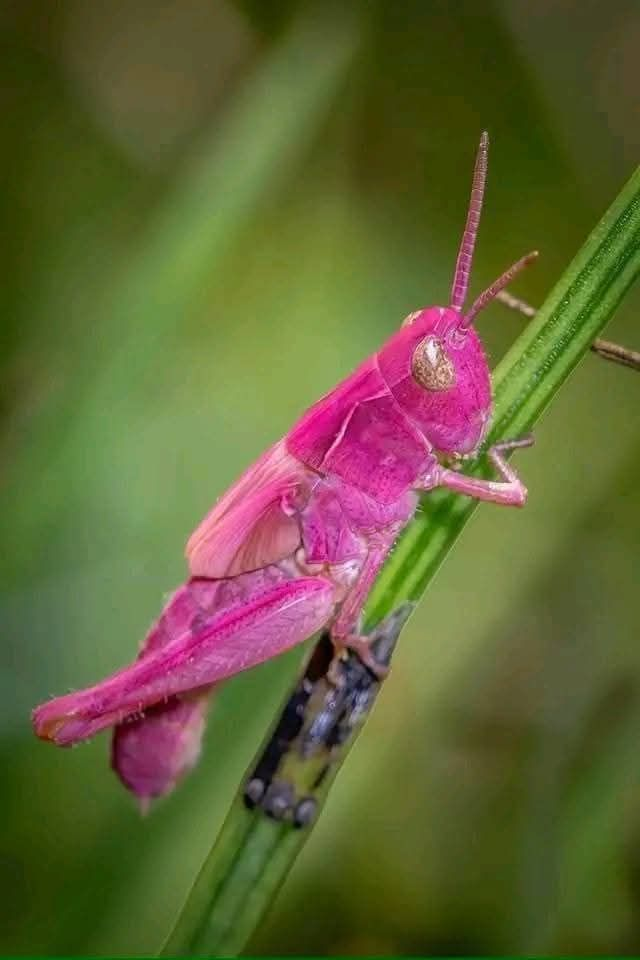A Rare Shade in the Grass: The Pink Grasshopper Mystery
In the vast green expanses where insects hop among blades of grass and stems, a startling surprise sometimes emerges: a grasshopper that isn’t green at all. Rather than blending in, it flaunts a vivid pink hue. These aren’t manipulated insects or artist-colored oddities — they’re real, wild creatures born with a rare genetic twist known as erythrism.
What Is Erythrism?
Erythrism is a genetic condition causing an abnormal red or pink pigmentation in animals. It’s the counterpart to albinism or melanism, but instead of lacking pigment or being unusually dark, the organism develops a reddish or pink cast. In grasshoppers with erythrism, the usual green wavelengths are altered, giving them their striking pink appearance.
This mutation is astonishingly rare — with estimates putting its occurrence at just one in 500,000 grasshoppers. That means in a population of half a million grasshoppers, perhaps one will carry this unusual trait.

Why So Rare?
There are two major reasons:
- Camouflage and Vulnerability
Grasshoppers’ typical green coloration serves a crucial function: blending into foliage, grasses, and plants to avoid detection by predators. A pink grasshopper stands out dramatically against its surroundings, making it a conspicuous target. Birds, lizards, frogs, and other insectivores are more likely to spot and snatch it up. - Genetic Rarity and Survival Pressure
The mutation that causes erythrism is likely recessive or dependent on multiple genes. Most carriers won’t express the pink trait, and many pink individuals won’t survive long enough to reproduce. Natural selection tends to weed out traits that significantly reduce survival odds. As a result, the gene remains extremely rare.
Encounters in the Wild: A Once-in-a-Lifetime Sight
Seeing a pink grasshopper in nature is such an oddity that photographers and nature lovers will often go their whole lives without encountering one. Some entomologists and insect enthusiasts devote great efforts to scanning meadows and fields, hoping to catch such a freak of nature on camera.
When captured in striking photographs, these pink grasshoppers quickly draw attention and intrigue. Their coloration seems eerie, almost ethereal — as if a tiny creature stepped out of a dream. Yet behind that surreal beauty lies a harsh reality: survival, reproduction, and risk.
What Can We Learn from Them?
Though rare, pink grasshoppers offer insight into evolution, adaptation, and genetic variation in natural populations:
- Genetic diversity — Mutations like erythrism remind us that wild populations harbor far more variety than meets the eye. Even traits that are maladaptive in modern environments may persist at low frequencies.
- Selection pressures — The extreme disadvantage of standing out demonstrates the power of natural selection: even beautiful traits can be detrimental.
- Conservation and study — If environmental changes reduce predator pressure or alter habitat coloration, rare traits might survive or even increase in frequency in unusual circumstances.
Could There Be “Pink” Variation in Other Insects?
Yes — erythrism and related pigment mutations appear in many animal groups, though always extremely rare. Examples include pink squirrels, pink deer (though those are usually leucistic or albino, not true erythrism), and other insects with reddish variants. The same pressures apply: if a pigment change reduces concealment or increases predation risk, it remains ultrarare.
Final Thoughts
The next time you walk through a meadow or peek under a blade of grass, imagine the possibility of spotting something astonishing — a grasshopper colored not in greens or browns, but in soft pinks, shimmering in the sunlight. Though fleeting and fragile, such a creature is nature’s reminder of how strange, beautiful, and unpredictable genetic variation can be.